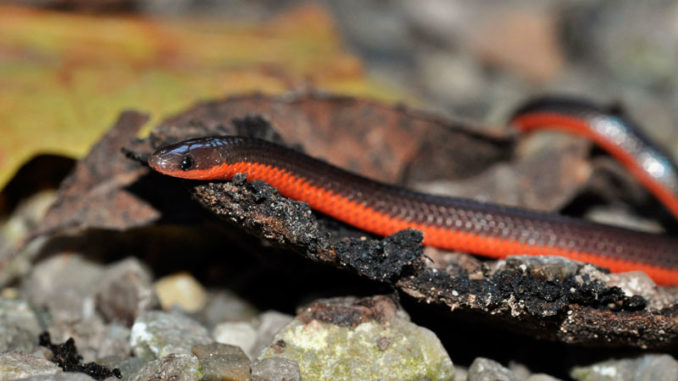
Think about all of the products you have seen or been told will keep snakes off of your property. I’ll wait. Okay, now forget about every single one of them. I’m back to share helpful information with our fellow outdoor-loving friends.
With temperatures rising, our cold-blooded compadres are becoming more and more active. Why are snakes more active during spring and summer? For the same reason that, on warmer winter days, you may see them “sunning” or hiding somewhere the sun has warmed up. Reptiles are cold-blooded and therefore, unable to regulate their own body temperature. They need an outside source, like the sun, to stay at a healthy temperature. So as the weather warms, these necessary and beneficial helpers are more likely to be out and about.
Since we can’t stop the seasons from changing, many are wondering, “Is there anything I can do to keep snakes away?” We love to see them, because snakes are natural predators of the pests and rodents we’re already trying to rid our property and gardens of. Smaller snakes take care of tiny pests like snails and slugs, while larger snakes eat the disease-spreading mice and rats that wreak havoc on our homes and crops. They are, in turn, a food source for other animals in our irreplaceable environment.
Repellents? Wrong
We’ll get to some tips for keeping snakes at bay, but let’s eliminate some that don’t work first. Snake-A-Way, Snake Be Gone, lime, sulphur, garlic, mothballs, other various chemicals or spices, and yes, even human hair. You’ve probably heard of at least one of these as a snake repellent. We have conducted tests with the most-popular products and old wives tales, but NONE of them deterred the snakes.
I know, I know, many people swear by them, but snakes don’t smell the way we do. They “taste” the air with their tongues. Then, their Jacobsen’s organ helps determine if those moisture particles represent friend, foe or food, all while their forked tongue tells them if the “smell” is to the left or right. Most so-called “snake repellents” claim the “bad smell” keeps them away. Well, snakes don’t know if something “stinks,” so they won’t even know it’s there, unless it hurts them physically.
Sadly, the most-awful options — glue traps and mothballs — are also the most-common, thereby earning them a special mention for those who love to enjoy Louisiana’s beautifully unique and diverse ecosystems.
Glue traps are nothing more than actual torture devices for any animal that happens to get ensnared in them. Many animals will literally rip themselves apart struggling to escape or succumb to a slow, agonizing death due to starvation. Mothballs, no matter who told you they work, do not work. Even worse, they’re a toxic pesticide that is dangerous and illegal to use in any way other than intended and directed, which is to place them, still sealed in their original packaging, in an enclosed storage space with clothing to deter moths. Please, never put mothballs, or suggest they be put, outside or loose in your home. The humidity in our air is enough to dissolve them. Once broken down, this noxious chemical seeps into the ground, contaminating plants and the groundwater that wildlife, even your pets, will drink. Remember, “The enemy of my enemy is my friend.” They may pilfer an egg now and then; just consider it a small price to pay for their pest-control services. No avid nature lover would choose such vile methods to exterminate innocent animals.
Discourage them
Since there’s no 100% foolproof way to keep snakes away, here are a few tips that may at least help you to see fewer snakes.
Keep your grass cut low, remove debris and stick piles where snakes or their prey, could hide, and keep standing water at a minimum. Snakes seek two things: food and shelter. By making your yard less desirable to them and their food sources, snakes won’t want to hang around. There are safe and humane ways to gently encourage a snake to move along. If they feel attacked, they’ll get defensive and possibly strike. This is why most people who get bitten do so while trying to kill the snake. As people who love and respect the outdoors, we have an incredible obligation to preserve and protect these animals and their environment. Now let’s take a look at five of the most-rarely seen and hardest to find out of the 48 snake species that live in Louisiana.
Ring-necked Snake (Diadophis punctatus)
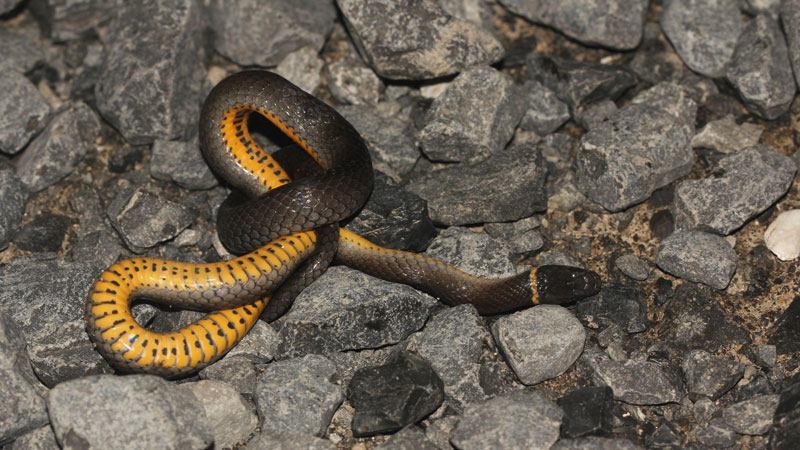
These snakes are typically solid grey or black, with a yellow-orange belly with small black spots, usually in pairs. They have a thin white or yellow band around the neck, giving the species its name. Due to their small size, they mostly feed on earthworms and smaller insects, salamanders and lizards. Most of their life is spent under logs, tree bark and other cover objects, so they’re rarely found on the surface. They prefer to live in bottomland forests but can be found in upland pine forests. Ring-necked snakes get to be 8 to 12 inches long. The maximum length known is around 18 inches. They occur in the eastern and central parts of Louisiana but aren’t found in the southwest region of the state. Although this species is mildly venomous, it is considered harmless because its venom is medically insignificant to humans.
Common Wormsnake & Western Wormsnake (Carphophis amoenus & Carphophis vermis)
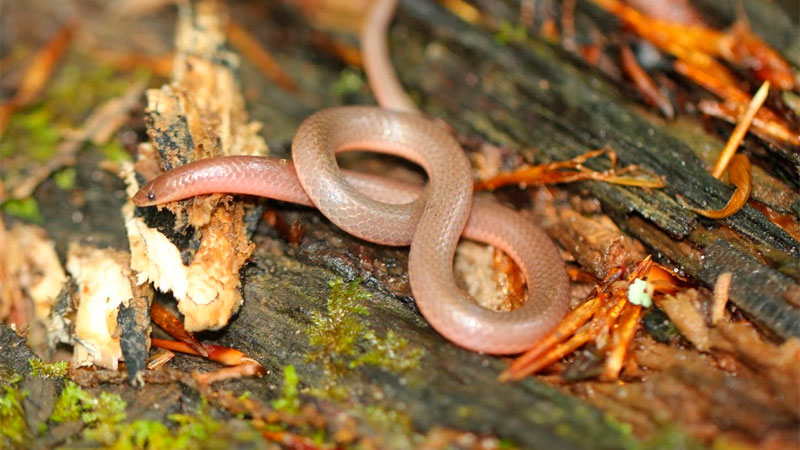
Both have smooth, glossy scales. Common Wormsnakes tend to be tan to dark brown along their backs with a pink or reddish belly that extends up one to two scale rows along the sides. Western Wormsnakes are more dark purple or black along the back with a pink or reddish belly that goes up to the third scale row along the sides. These will reach on average 71/2 to 11 inches long. The record is almost 14 inches. They do have venom, but it won’t bother most humans more than a little swelling near the bite. Their “rear-fangs” are elongated, grooved teeth on the back of their upper jaw. These require them to “chew” on prey to deliver venom, unlike the quick bite of front fangs. Their diet can include slugs or other small creatures that fit in their mouth, but it’s almost exclusively earthworms.
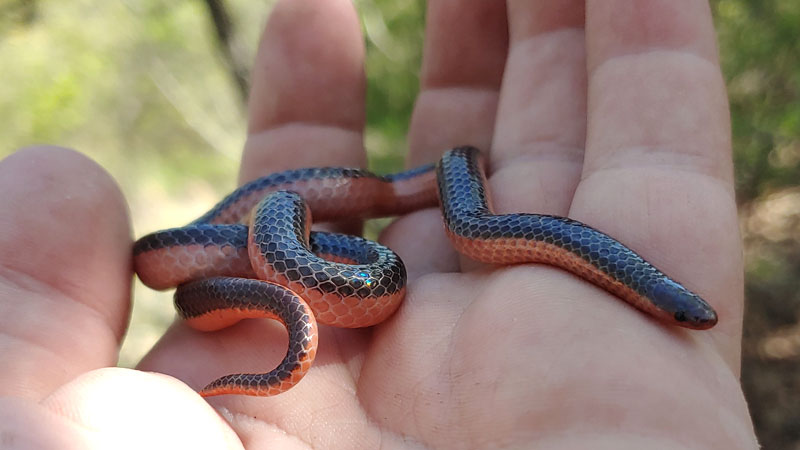
Wormsnakes live mostly underground in moist woodlands or swamps and forested habitats near the coast. They’re usually found in rotting logs, under rocks or leaves or in loose soil, but not in the same area. Commons are located in the Florida parishes and Ascension Parish, while Westerns are in only a few parishes in North Louisiana. If you happen to hold one, they may poke you with their pointed tail-tip, but this is to hold down prey so they have time to eat, and it is completely harmless to humans.
Eastern Hog-nosed Snake (Heterodon platirhinos)
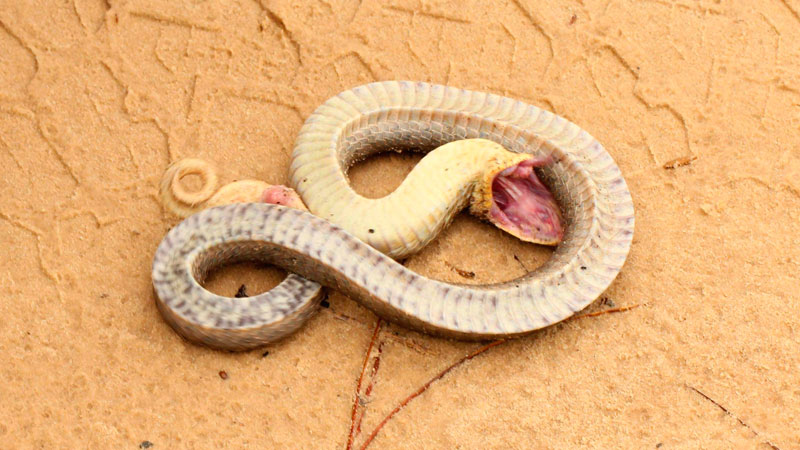
These interesting snakes, with their keeled scales and upturned snout, are active mostly during the day and found only in the United States. Their “background” color can vary from yellow, gray, brown and olive green to orange or red. Some look “spotted” or have a pattern of dark rectangle, or eye-shaped spots down their backs. The underside of the tails is usually lighter in color than their bellies, which could be yellow, light gray, or pink with some grey. These guys can be 2 to 3 feet long. The longest on record was slightly longer than 4 feet. They, too, are rear-fanged snakes with prey-specific venom for invertebrates and small mammals, birds, frogs and salamanders, but their favorite is toads. “Hoggies,” as we like to call them, live in sandy soil, woodlands, fields, farmland or coastal areas, and they can be found almost all over the state. They’re less common in the southeastern region. They rarely bite, and when threatened, these melodramatic over-actors will suck in air, flatten their heads, spread the skin around their necks like a cobra, hiss and lunge, pretending to strike and emitting a foul smell. If that display doesn’t work, they’ll flail around and flip over with their mouth wide open to “play dead”. This extraordinary performance has earned them nicknames like “spread-head moccasins” or “hissing sand snakes”.
Pine Woods Littersnake (Rhadinaea flavilata)

These little guys have smooth scales, and along their backs, they are golden brown, reddish orange or brown. The top of the head is noticeably darker than the rest of the body, and they’ll have darker lines on each side of the face that go through their eyes, similar to the “zorro mask” that cottonmouth water moccasins have. A Pine Woods snake’s belly can vary from white to pale yellow or yellowish-green. This lighter color extends to their second or third row of scales. While usually 10 to 13 inches, the record length is slightly less than 16 inches. Their toxic saliva can subdue prey such as small frogs, salamanders, snakes and lizards, but it is not harmful to most humans. They enjoy a habitat with damp woodlands, wetlands and coastal islands, but are mostly in piney, flatwood areas. They too can be found under tree bark and leaves, in rotting logs, in loose soil pretty much statewide, except in southeasternmost parishes. Pine Woods Littersnakes have yellowish or cream colored upper lip scales, so if you come across a “yellow-lipped snake”, as they are often called, you know what you’re looking at.
You can read more snake articles below:
Thanks for being willing to take time to learn important facts about snakes that you, or someone you know, could encounter during almost any outdoor activity in Louisiana. Come back next time to see some stunning snakes that are considered to be the most remarkably beautiful in the state, and even the country. Until then, be sure to check out Louisiana Snake ID Facebook page for lots of snake facts and fun. They can also be found at LA Snake Boyz on YouTube and www.louisianasnakeid.com. Snake education is their passion!